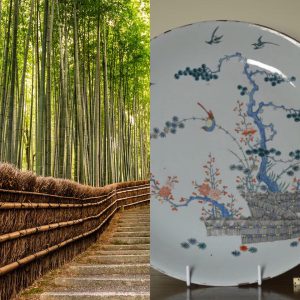
A 17th Century Japanese Kakiemon Porcelain Bowl
A 17th Century Japanese Kakiemon Porcelain Bowl. The shallow octagonal form with everted rim is painted using Kakiemon enamels depicts a garden scene. A tree, perhaps a prunus ume, grows from a ‘banded hedge’ / bushwood fence, called a shibagaki in Japan. To the left are asters supported by a bamboo trellis. The rim is dressed with iron-oxide enamel, called Kuchibeni (Meaning lipstick) in Japan.
SOLD
- Condition
- In very good condition, some wear and minor chipping to the enamels in the centre.
- Size
- Diameter 15.3 cm (6 inches)
- Provenance
- Property from a New York Collection formed in the 1980s. The base has an old collection label "W W W". This could conceivably be William Winkworth. A blue and silver label to the base "Guaranteed Genuine, Art Trading Ltd, David B. Newbon, 305 East 61st Street, New York City".
- Stock number
- 26008
Information
Kakiemon Porcelain
Kakiemon decoration is usually of high quality, often delicate and with well-balanced asymmetric designs. The designs were normally quite sparse emphasizing the fine white porcelain body known in Japan as Nigoshide (milky white). The opaque white milky Nigoshide body was used on the finest pieces, it appears that it was reserved for fine quality enamelled decoration. Kakiemon porcelain was decorated with a great variety of imaginative designs which include elements such as the `banded hedge`, `flying squirrel`, and the `Quail and Millet` design. The `Three Friends of Winter` were also a very popular group of designs, other subject taken from nature include flowers (especially the chrysanthemum, the national flower of Japan) as well as birds and rock-work. Figural subjects such as the `Hob in the Well` were also popular. This design illustrates a Chinese folk tale where a sage saves his friend who has fallen into a large fish-bowl by throwing stones at it, braking open the pot. Banded-Hedges were a formal device within Japanese traditional gardens, they were often incorporated in designs, includes `The Three Friends of Winter` (Pine, Bamboo and Prunus). These three plants signify perseverance, as neither the pine nor the bamboo shed their leaves in winter and the plumb (Prunus) flowers at the very end of the winter, heralding the arrival of spring.
Nigoshide Body
The Nigoshide (milky white) body was a new whiter porcelain body introduced between about 1660 – 1680, solely for use on Kakiemon Wares. Indeed the Kakiemon Palette evolved at the same time. It has recently been proposed that the Nigoshide Body is not a new body at all, rather it is just made from a clay that has been levigated and washed more thoroughly.









